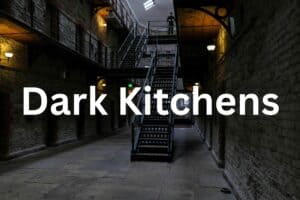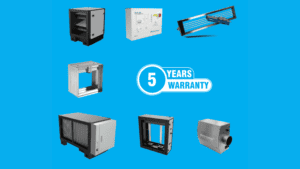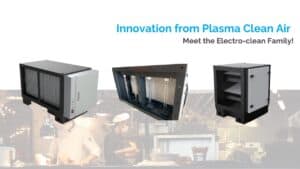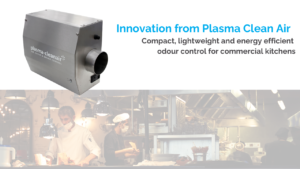For Architects, M&E and Foodservice Ventilation Consultants the successful conclusion of a commercial kitchen project usually takes place when the job is handed over. As we’ve seen in the first part of this series of two articles on considerations when designing a new, or upgrading an existing commercial kitchen, this isn’t always the case. Chris Tattersall, Sales Executive of Plasma Clean, explains how one restaurant found itself being served a 70-day notice to close by an Environmental Health Officer (EHO) shortly after it commenced trading.
“When a Lebanese restaurant opened its doors to the public it was with the aim of providing its customers with delicious, fresh, char-grilled Middle-Eastern cuisine. The restaurant was located in a built up residential and commercial district sandwiched between a University and a shopping centre. Within weeks of opening the restaurant found itself the subject of a series of complaints about the odours and smoke emitting from the kitchen extract system. With these complaints made directly to the City council, it wasn’t long before the EHO was called in to investigate.
The restaurant premises are surrounded by commercial offices and there are residential properties directly above. On attending site, it became evident to the EHO that the complaints made against the restaurant had merit. The change of cooking method, from a simple café to providing a menu based on char-grilling had resulted in a large increase in smoke, grease and odours being emitted from the kitchen extract system, becoming a real nuisance to the restaurant’s neighbours.
Following a series of communications between the EHO and the restaurant, a 70-day notice to close or to rectify the kitchen extract ventilation was served. With no experience or understanding of this problem the restaurant called in an architect to review and provide a solution. The architects turned to Plasma Clean, as specialists in this area and having a wealth of experience of providing successful odour control solutions across a wide range of commercial kitchen projects.
Plasma Clean attended the restaurant to carry out an odour risk assessment, and survey the existing kitchen extract system. The odour risk assessment score determines whether the kitchen extract ventilation system is a medium, high or very high risk, and the restaurant came out as a very high risk. This was mainly due to the proximity of the neighbouring properties – know as ‘receptors’ from the discharge point and the nature of the cooking. Char-grill cooking is notorious for producing very high levels of grease, smoke and odours.
Whilst inspecting the kitchen extract ventilation system we discovered that there was already an activated carbon system in place, which had been retained from when the restaurant was converted from a café. The owner thought that this would have been sufficient to cope with the change to char-grill cooking, but whilst activated carbons are an effective form of gasous odour control, they are not suitable for grease and smoke abatement.
Once the survey was completed it was clear that a bespoke grease, odour and smoke control strategy was required. The difficult part was how the odour equipment would incorporate into the existing ventilation system, whilst keeping the additional pressure drop as low as possible, and making sure that disruptions to the restaurant were kept to a minimum.
For the primary grease filtration we opted for high efficiency canopy mounted grease filters, which replaced the existing low efficiency baffle-type grease filters. This ensured that the ductwork would be kept relatively clean, whilst reducing the maintenance requirements and increasing the operational life and efficiency of the odour control equipment further downstream. To remove the cooking odours, the Xtract 2100 ozone injection system was installed. Ozone is a well known disinfectant and odour neutralizer which eliminates odours as opposed to masking them. To eliminate the smoke and secondary grease we selected an in-duct mounted Electrostatic Precipitator which operates by ionising and trapping grease and smoke particles onto collector plates. As this was a particularly sensitive application, we decided to keep the existing activated carbons at the end of the system to act as a final polish and absorb any residual ozone.
The recommendations were approved by the EHO without amendment, and work got underway for the retrofit. This was carried out successfully and the 70-day notice to close was revoked following the EHO’s follow up examination.”
Following on from the previous article, there are five main areas to consider when selecting an odour, grease and smoke strategy which can differ on each application. From our experience, every commercial kitchen will benefit from an odour risk assessment at the earliest stage, as once trading if there are issues with odour, grease or smoke , the implications can be costly. By calling in specialists at the beginning of a commercial kitchen project, odour, grease and smoke control strategies can be addressed in advance with a minimal impact on the overall cost and timescale of a project.
To arrange a free consultation, contact Plasma Clean who will provide specialist expertise and guidance on the most appropriate grease, smoke and odour solution for your kitchen project.








